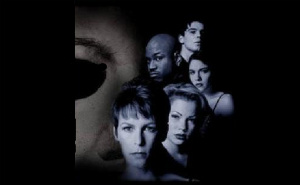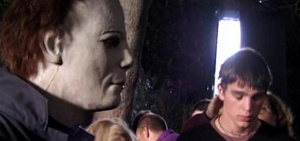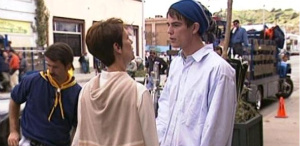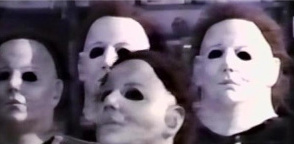
Director: Steve Miner
Writers: Robert Zappia, Matt Greenberg, Kevin Williamson
Starring: Jamie Lee Curtis, Adam Arkin, John Hartnett, Michelle Williams
Rating: R (USA), 18 (UK), M (Australia)
Christmas 1996 would not be owned by the Academy Award winning Jerry Maguire, the crowd pleasing spoof Mars Attacks! or the much-anticipated musical Evita, but by a slasher written by a failed actor and directed by the man responsible for creation of Freddy Krueger. Its US opening weekend of $6,354,586 would bring the slasher film kicking and screaming back into the mainstream after almost a decade of pointless sequels and generic efforts. It was inevitable that this newfound interest in the genre would prompt producers to dust off their old villains and bring them back in a stylish, postmodern fashion. The first was Michael Myers, who had been in hiding since the embarrassment of Halloween 6 and had been all but forgotten by his owners. But the popularity of Scream, which had heavily referenced John Carpenter’s classic throughout, had single-handedly reinvented the genre by making the characters smart and aware of the conventions of the slasher film. Whereas the most recent slice ‘n’ dice efforts had been sentenced to the bottom of the bargain bin, Scream had kickstarted the genre once again, much like Halloween and Friday the 13th had fifteen years earlier. In its wake, other blockbusters would surface, such as Scream 2, I Know What You Did Last Summer, Urban Legend (which had co-starred Jamie Lloyd herself, Danielle Harris) and Halloween 7.
Despite becoming one of the most successfully actresses in Hollywood, Jamie Lee Curtis had never forgotten her roots or how much she owned her career to Laurie Strode, Halloween‘s naïve protagonist. In the two decades since its release, she had progressed from horror icon to A-list movie star with turns in blockbusters like Trading Places, A Fish Called Wanda and True Lies. But, in 1996, a friend’s casual reference at the twentieth anniversary of the original movie slowly approaching, Curtis finally began to entertain the idea of returning to the character that gave her a career. Enthusiastic about the prospect, Curtis began to pitch the idea to both Dimension, who had owned the rights since their involvement with The Curse of Michael Myers, and the original movie’s director, John Carpenter. Initially intrigued, Carpenter met with Moustapha Akkad and began to discuss one last Halloween movie, with Carpenter suggesting various scenarios with which to take the franchise in a new and exciting direction. But his requested fee of $10m, which was to also include compensation for revenue he was never paid from the first film, was rejected by Akkad and so he eventually declined.

With Carpenter no longer attached, Dimension were forced to search for a writer, someone who knew the franchise inside and out and could extract the best elements from the previous films and bring back Laurie in an interesting way. Their second option was Kevin Williamson, who had not only penned not only the two Scream movies for Dimension but also I Know What You Did Last Summer for Columbia Pictures, but due to prior commitments on his semi-autobiographical television soap Dawsons Creek was unable to accept, although he would draft up a seven-page treatment which the studio would use, eventually hiring in-house with Matt Greenberg and Robert Zappia, who would faithfully adapt Williamson’s concept into a feature script. Curtis would also play a vital role in the development of the story, as she had invested herself heavily into the character once again and was determined to bring some kind of resolution to Laurie and was insistent that there had to be a point where she would be forced to turn the tables on her pursuer.
Halloween H20, as it would become known, centred on the idea that Laurie Strode has been living with the nightmare of Michael Myers for twenty years, having spent countless time and money on therapy and various other treatments, including alcohol. Now living under a new name, Keri Tate, Laurie is the principal at a private boarding school where her son, John, is a student. Attempting to lead a normal life and form a lasting relationship with her colleague, Charles Deveraux, Laurie’s fears come true when Michael appears, once again on Halloween, to finish what he had started two decades ago. Eventually, when there is no where left to run, Laurie is forced to face her psychotic brother and, after a crash which results in him being pinned to a tree, she finally decapitates him. Both Williamson and the writers had to decide how much of the sequels to reference and which parts to dismiss. It had been mentioned in Halloween 4 that Laurie had died in a car crash and that her daughter, Jamie had been adopted. This justifies why, in H20, she now lives under a different name, though there is no reference of a daughter. In fact, Halloween 7 seems to ignore every sequel after the second, which marked Curtis’ last involvement with the franchise.

There were several differences between Williamson’s treatment and what was filmed. For instance, originally it had been the house of Dr. Loomis’ daughter, Rachel, who Michael had broken into during the opening sequence in order to gain an address for Laurie, while in the movie it was Marion Chambers, the doctor’s assistant from Halloween and Halloween 2. Another scene, which was designed to please the hardcore fans, would have featured a bitchy student, Sara, presenting an oral report on the murder spree of Haddonfield, referencing several key points from the sequels, including the existence of Jamie Lloyd. The character Sara would be changed to Sarah, who would become one of the key young characters, minus the attitude problem. Another character to be jettisoned from the treatment was Mick, who was to be the object of Molly’s affection, in later drafts become the girlfriend of John Tate. Michael’s death was to have been different in Williamson’s version. Instead of a decapitation by an axe (which was much in keeping with the slasher theme), he was initially to have been sliced in half by helicopter propellers. Williamson’s contribution to the treatment earned him an ‘executive producer’ credit, although he would be called back later to provide a rewrite.
With the previous instalments all being helmed by directors new to the genre, Dimension and Akkad decided to hire a veteran who would already be familiar with the convention of the slasher film. They eventually opted for Steve Miner, who had worked his way up the food chain as an assistant on The Last House on the Left and Friday the 13th before being promoted to the director’s chair for the latter’s first two sequels. He would spend the following fifteen years balancing his genre work such as House and Warlock with more family-orientated projects such as Forever Young. Miner, who had been a fan of Halloween since its release in 1978, despite not being a lover of horror, would heavily reference Carpenter’s classic throughout his sequel, recreating various shots or lines of dialogue that the fans would pick up on. Another, more subtle reference, was in the casting of Janet Leigh, the star of Alfred Hitchcock’s seminal masterpiece Psycho (and mother of Jamie Lee Curtis), whose character in Halloween H20 would also drive the same car, a 957 Ford Custom 300, that she had done in her earlier movie.

With a budget of $17m, filming commenced on February 7 1998 at the Canfield-Moreno Estate in Silver Lake, California, which would double as the boarding school. In fact, H20 would mark the first Halloween movie to be shot in California since Season of the Witch in 1982. One major issue that the filmmakers came across was with regards to Michael’s iconic mask, which the studio had hired KNB (who had also worked on Scream) to recreate. But when a crew member expressed outrage at the mask not resembling the previous films, the producers panicked and brought in John Carl Buechler, who had designed the one for The Curse of Michael Myers. When Miner discovered that this decision had been made without his authority, he took both KNB and Buechler’s designs to Stan Winston’s studio and asked for them to create a mask that would resemble the best of both. Unfortunately, several scenes had already been shot with stuntman Chris Durand, who was portraying the killer this time around, and so Miner was forced to have the mask digitally altered during post production.
Another factor that caused controversy was with the replacement of composer John Ottman with Dimension regular Marco Beltrami, going so far as to hiring a team of music editors to add samples of Beltrami’s scores from Scream, Scream 2 and even Mimic. This decision had been at the insistence of studio head Bob Weinstein, who had viewed a cut of the movie and had been unimpressed with the score. Halloween H20 was finally released nationwide on August 5 1998, two months shy of its twentieth anniversary. On its opening weekend it almost made its entire budget back by earning an astonishing $16,187,724, before going on to earn a domestic gross of $55,041,738, making it the most profitable entry in the franchise at that time. Despite the definitive death of its star, Michael Myers, once the box office figures were presented it became clear that another sequel would soon appear.


One Response to HE CAME HOME pt.7 – Halloween H20 (1998)